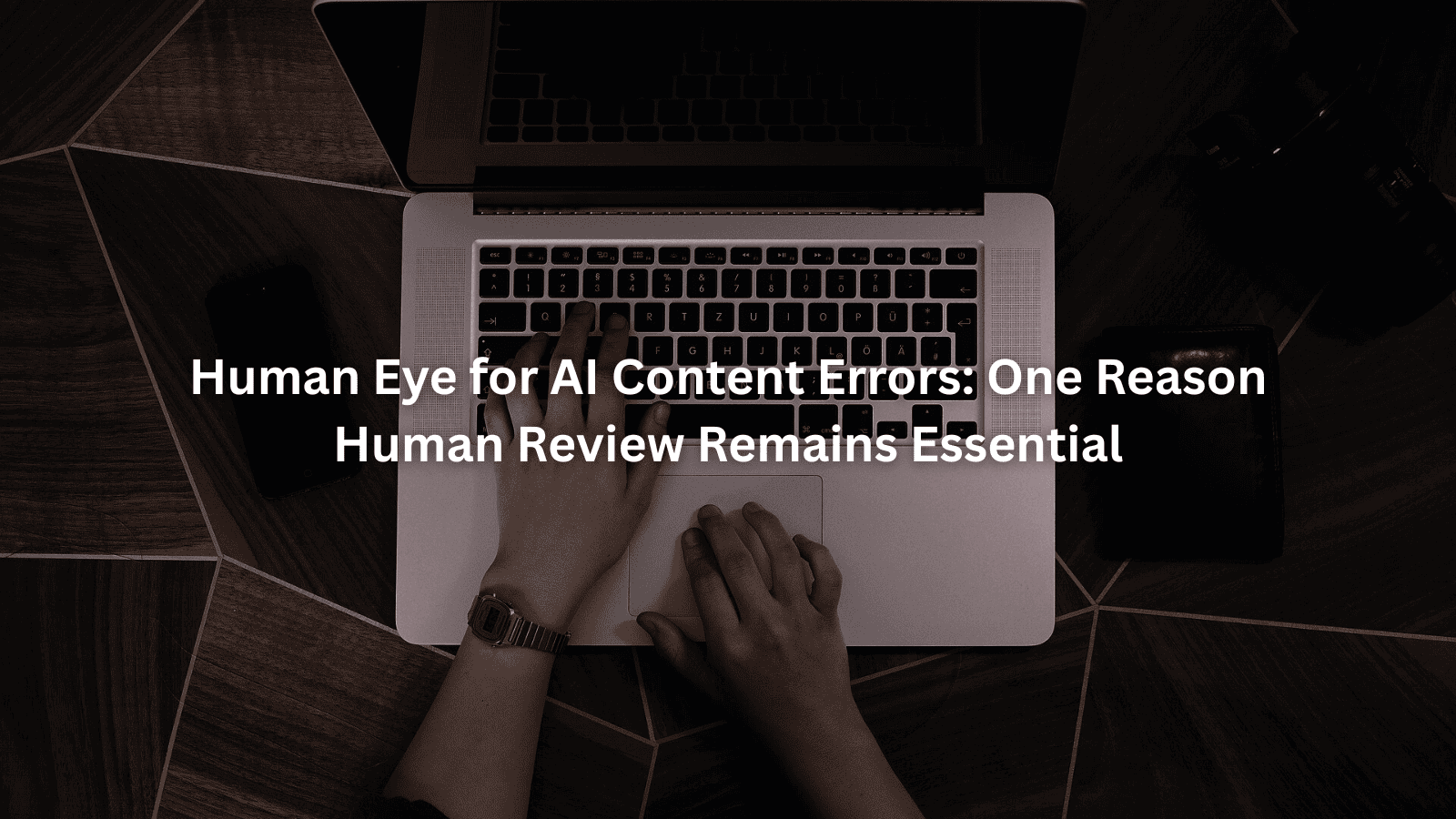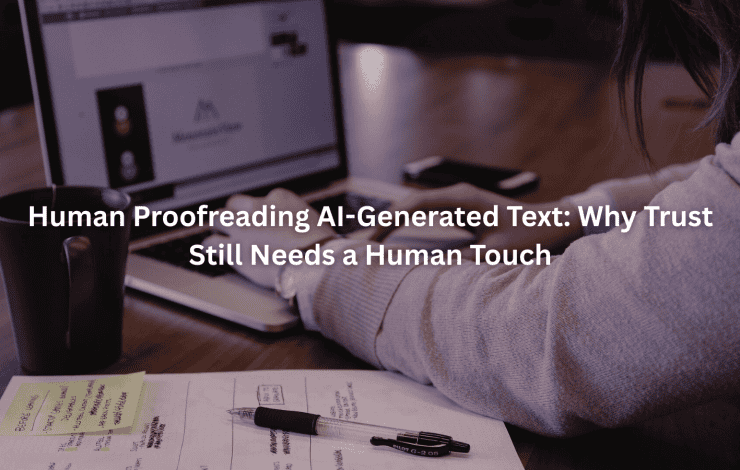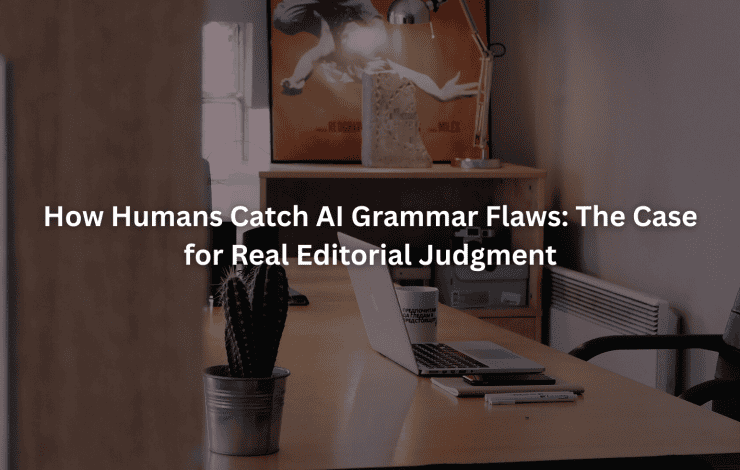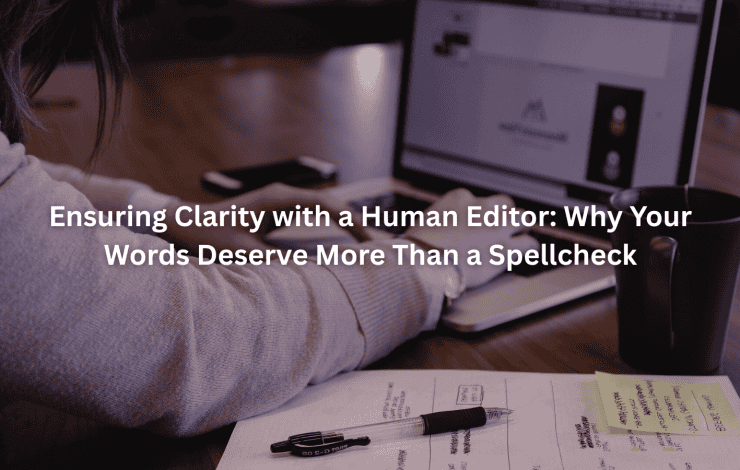Use your eyes and your gut, AI content errors slip through cracks that only a person can see. Our editors spot tone mismatches and logical flaws AI tools gloss over. We catch cultural blunders and out-of-context claims that wouldn’t fool a real reader. This is why, even as AI drafts faster, the human eye is still the final judge for quality.
Key Takeaways
- Human review catches subtle, contextual, and emotional errors that AI tools miss.
- Relying only on AI leads to tone shifts, hallucinated facts, and cultural missteps.
- Combining AI drafting with human editing, like what we do at Jet Digital Pro, gives you content that’s accurate, engaging, and on-brand.
The Role of the Human Eye in Detecting AI Content Errors
We’ve all seen it. A paragraph looks fine at first, but then something feels off. Maybe a phrase just doesn’t sound right, or the logic skips a beat between sentences. This is where the human eye steps in, right at the intersection of accuracy and authenticity.
Understanding AI Content Limitations
AI is great at pattern recognition. It processes data and spits out sentences at a speed we can barely imagine. But it doesn’t “see” context like we do.
As some researchers note, while AI can generate grammatically sound sentences, its limitations become evident in real-world use, especially in tasks that require nuanced understanding and contextual awareness [ 1 ].
Contextual Misinterpretations and Inaccuracies
AI loves to generalize. A machine can’t always tell if a reference to “the game last night” is about baseball, basketball, or even a video game. We’ve found AI often places facts out of time or geography, inventing connections that don’t exist. In one case, an AI wrote about summer festivals in December for an Australian client, something only a human editor would notice and fix.
Tone and Voice Inconsistencies
Tone is slippery. One moment the draft is formal, the next, it’s breezy and casual. AI models, no matter how advanced, lack the lived experience to maintain consistent brand voice throughout an article. We regularly spend time smoothing out these shifts so the writing actually sounds like it belongs to one mind.
Logical and Factual Fallacies
We’ve seen AI “hallucinate” facts. It invents statistics or events, especially when it can’t find real data. In our work, this happens about one in every ten long-form drafts. These aren’t always obvious unless you know the subject well, which is why our fact-check process always involves a human.
Cultural and Ethical Sensitivity Challenges
AI just doesn’t get humor, sarcasm, or cultural nuance half as well as a person. One time, it described a Halloween tradition to a client in a country that doesn’t celebrate Halloween. Another time, it missed a loaded term that would have been offensive in some contexts. These are the moments we step in, adjust, and make sure the content is safe and relevant.
Why Human Review Surpasses AI Detection
Recognition of Nuance and Subtle Error Patterns
AI tools flag grammar and spelling. We notice when a sentence feels “off” even if it’s technically correct. For example, a phrase might be grammatically flawless but carry a meaning that doesn’t fit, a nuance only someone with human judgment can spot.
In fact, some platforms now offer AI-written content detectors because audiences and editors alike have learned to spot the patterns of machine-generated text [ 2 ].
Adaptive and Subjective Judgment Capabilities
There’s no rulebook for style. Sometimes, breaking grammar rules is exactly what makes writing more compelling. We use our own judgment to decide when to bend or break the rules for effect, something AI can’t do without strict instructions.
Emotional Intelligence in Narrative Flow and Engagement
We know how a story should feel. AI-generated drafts often lack a natural narrative arc, or they miss emotional cues that keep readers hooked. We rewrite sections to add flow, tension, or relief, drawing from our own experience as readers and writers.
Identification of AI Hallucinations and Misinformation
AI sometimes invents quotes, sources, or data. We double-check unfamiliar claims, tracing them back to original sources. Our process includes not just reading with a critical eye, but also using fact-checking tools and our own experience to spot misinformation.
Categories of AI Content Errors Detectable by Humans
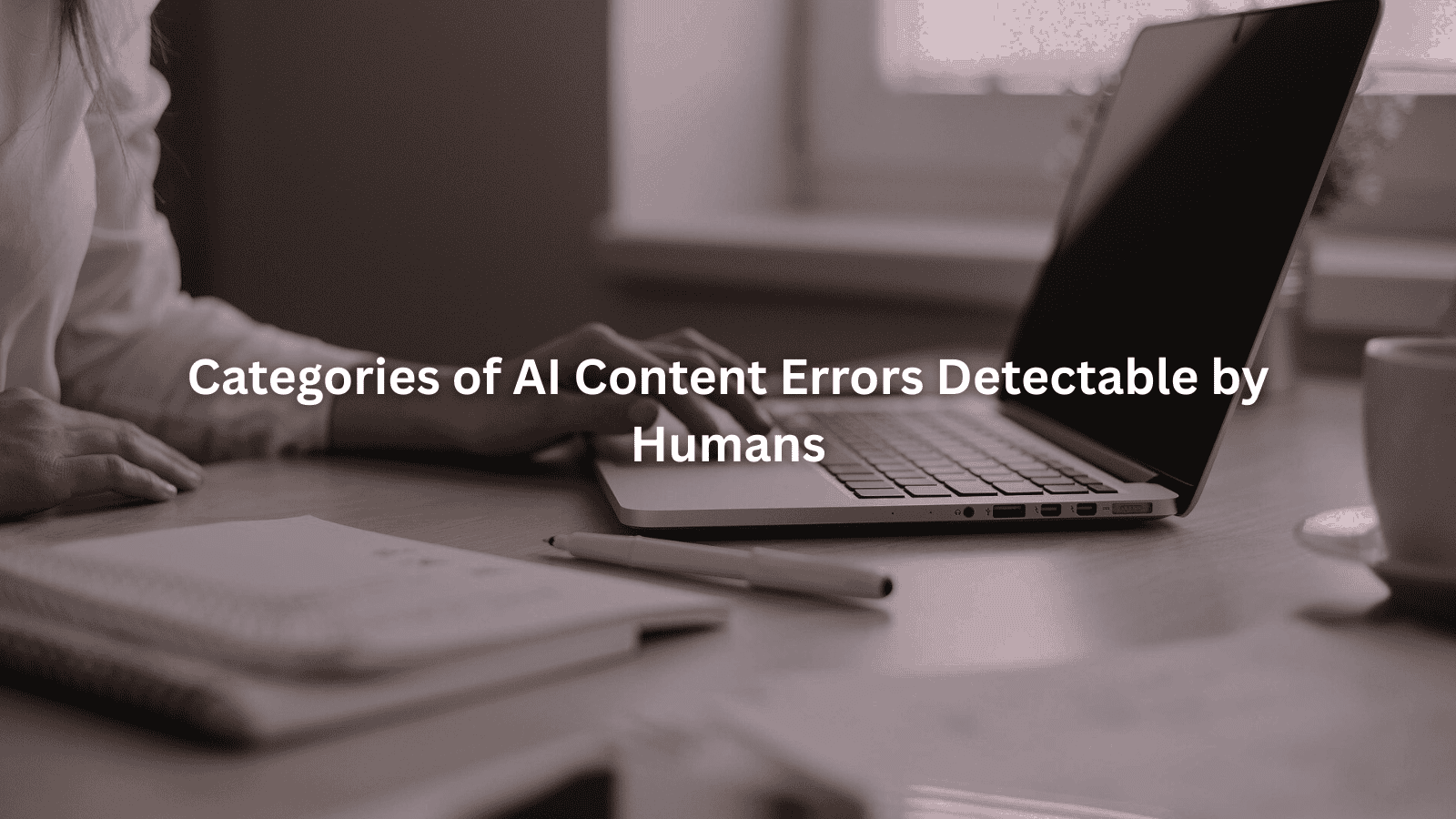
Some errors are so subtle only a person would notice. Here’s where our human review shines.
Out-of-Context Information and Semantic Errors
We catch when a passage doesn’t fit the topic, or when the AI mixes up time, geography, or subject. For example, we once found a draft referencing “spring fashion trends” for a client in Brazil, where the seasons are flipped.
Temporal, Geographic, and Topical Discrepancies
- AI confuses northern and southern hemisphere seasons
- References events that don’t exist in the target region
- Mismatches between topic and supporting examples
Misuse of Idiomatic and Jargon Expressions
Idioms and jargon are tricky. AI often applies them literally or in the wrong context. We replace phrases that don’t make sense culturally or professionally, making sure the text sounds natural to the intended audience.
Repetitive Phrasing and Redundancy Issues
AI tends to repeat itself, especially with keywords or common phrases. This makes the content dull and robotic.
Detection of Keyword Stuffing and Verbosity
We spot:
- Overuse of target keywords (hurting SEO and readability)
- Long-winded explanations that could be concise
- Sentences that say the same thing in three different ways
Ensuring Phrase Variation and Readability Improvement
We rewrite repetitive sections, introduce variety, and break up long paragraphs. Our edits aim for clarity and engagement, not just correctness.
Tone, Style, and Brand Voice Inconsistencies
AI struggles to stick to a single voice. We see this most clearly in longer pieces, where the style can shift mid-article.
Stylistic Alignment and Audience Targeting
We make sure:
- The writing matches brand guidelines
- The voice stays consistent from intro to conclusion
- The content actually addresses the intended audience
Passive Voice and Sentence Structure Adjustments
AI can overuse passive voice. We revise sentences for active voice and better flow, improving clarity and energy.
Factual Accuracy and Plagiarism Concerns
AI is prone to errors and unintentional copying. Our review process catches both.
Fact-Checking Processes and Ethical Review
We:
- Verify statistics and claims with primary sources
- Flag and remove potential bias or ethically questionable statements
Plagiarism Detection and Content Originality Verification
Using both software and our editorial knowledge, we check for:
- Copied or closely paraphrased text
- Recycled phrases that could trigger plagiarism flags
- Ensuring the final draft is unique and original
Human Oversight Techniques for Enhancing AI-Generated Content
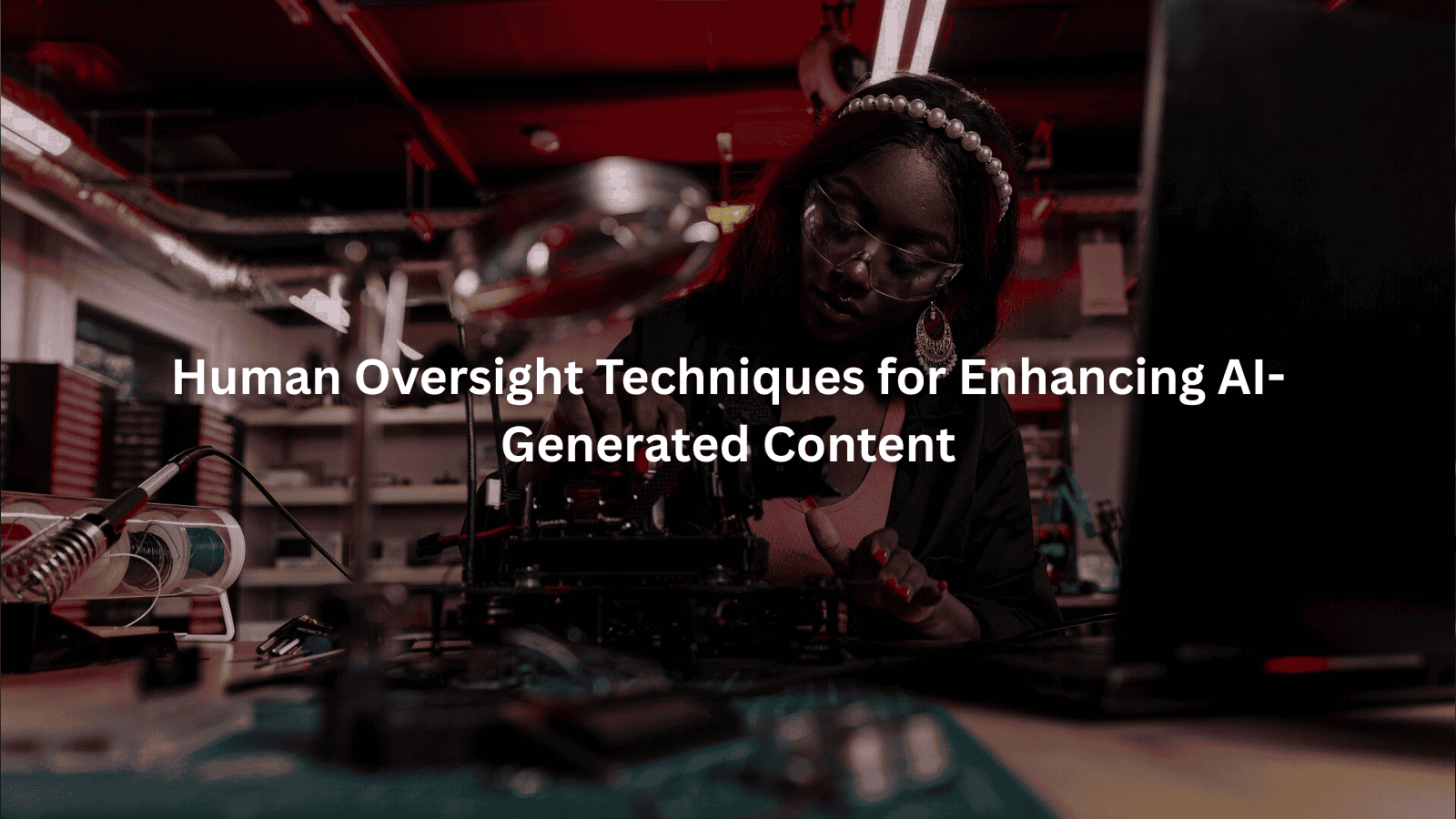
Editing isn’t just about fixing mistakes. It’s about making content better, clearer, and more engaging.
Deep Editing and Creative Insight Application
We don’t just correct errors. We inject our own creativity and experience. For example, an AI draft about travel insurance missed the most important aspect, real-life anecdotes. We added stories from our own travels, making the content relatable.
Beyond fixing surface issues, we enhance structure through advanced grammar editing done with human-AI insight, which allows us to maintain the writer’s voice while elevating clarity.
Preserving Meaning and Idiomatic Usage
We ensure meaning isn’t lost in translation. If the AI uses a phrase that doesn’t fit, we find a better one. We also swap out awkward idioms for natural alternatives.
Clarity Enhancement and Verbosity Reduction
We trim unnecessary words, clarify confusing sections, and make sure each sentence has a purpose. We strip away clutter and focus each sentence by applying clarity through human editing, not just fixing errors but shaping intent.
Quality Assurance through Contextual and Logical Flow Checks
AI drafts can jump around or lose logical thread. Our editors read for flow, making sure ideas connect smoothly.
Narrative Flow and Content Coherence Assessment
We:
- Rearrange paragraphs for better storytelling
- Add transitions to keep readers engaged
- Remove tangents and keep the main idea front and center
Logical Consistency and Error Pattern Recognition
We look for:
- Contradictory statements
- Gaps in logic or missing steps in explanations
- Recurring errors that might signal deeper issues
Integrating Human Feedback with AI Tools
We use technology to speed up surface checks, then rely on our own judgment for the deep stuff.
Adaptive Correction and Prompt Engineering
We adjust AI prompts based on recurring errors, teaching the model to do better over time.
Use of Readability Scores and SEO Optimization
We check readability and SEO metrics, making final tweaks to ensure content is both discoverable and pleasant to read.
Editorial Discretion and Ethical Considerations
Some choices can’t be made by machines.
Cultural Sensitivity and Misinformation Spotting
We keep an eye out for:
- Potentially offensive or insensitive language
- Outdated or debunked claims
Maintaining Brand Voice and Writing Style Consistency
Are You a Digital Agency?
White Label SEO Content Services for Agencies
Scalable, customizable, and results-driven content solutions for your clients.
Our editors make sure every article sounds like it came from the same place, your brand.
Best Practices for Combining Human and AI Content Review
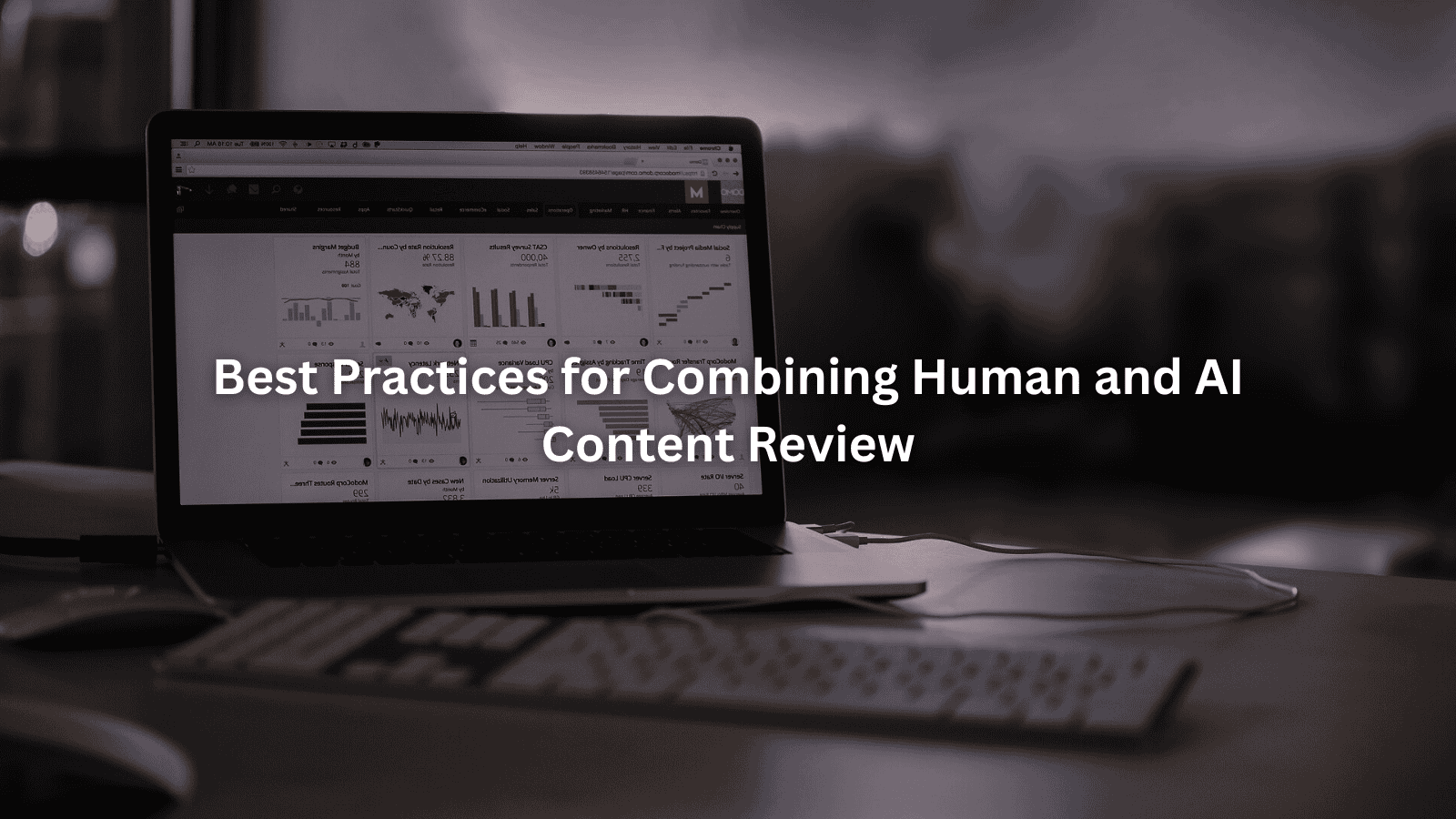
We’ve found the best content comes from blending AI efficiency with human judgment. We’ve learned that combining automation with a human AI editor for proofreading and grammar helps ensure surface-level accuracy without sacrificing tone or intent.
Workflow Integration of AI Drafting and Human Editing
AI handles the heavy lifting, while we do the fine-tuning.
Efficient Use of AI for Surface-Level Proofreading
We let AI flag:
- Grammar
- Spelling
- Punctuation
Human Review for Contextual and Stylistic Refinement
We handle:
- Tone
- Brand voice
- Contextual accuracy
- Audience alignment
Subject Matter Expertise and Specialized Reviewers
For technical or sensitive subjects, general editing isn’t enough.
Technical Accuracy and High-Stakes Content Validation
We bring in subject matter experts, real people with real experience, to review drafts for:
- Technical correctness
- Factual depth
- Relevance to industry standards
Iterative Review Processes with Peer and User Feedback
We encourage:
- Multiple rounds of editing
- Peer review within our team
- Client feedback for continuous improvement
Balancing Automation and Human Judgment
The trick is not to lean too heavily on either side.
Avoiding Over-Reliance on AI Detectors
AI can catch typos, but it misses nuance. We use it as a tool, not a crutch.
Continuous Improvement of Content Quality and Relevancy
Our review process is always evolving. We learn from each project, updating our workflows and prompts to catch new error patterns.
Practical Advice
Need a Strategic SEO Content Partner?
Let’s craft SEO content that ranks, converts, and grows your brand.
Talk to UsIf you want content that feels human and reads well, use AI for speed but trust your own eyes for quality. Always read drafts out loud. Listen for awkward phrasing and mismatched tones. Get a second opinion when possible, especially for technical or sensitive topics.
At Jet Digital Pro, we’ve built our workflow around this hybrid method. Our editors spend just as much time fixing logic and tone as they do fixing grammar. That’s how we help agencies deliver content that’s accurate and engaging, not just error-free.
It’s all about balance, let AI work for you, but let your judgment have the final say. If you want content that stands out, don’t skip the human review.
FAQ
How does the human eye catch subtle tone mismatches that AI tools often overlook?
Humans naturally pick up on tone shifts that feel out of place, even when the words are correct. For example, if a draft suddenly goes from casual to overly formal mid-article, it can jar the reader. AI tools might miss these shifts because they focus on grammar and spelling, not emotional flow. Our editors read with feeling and context, which helps us smooth out these awkward transitions.
Why are idioms and cultural references challenging for AI, and how do humans fix these errors?
AI models don’t always understand local sayings or cultural references, so they use phrases in the wrong situations. We’ve seen AI use idioms that make no sense to the target audience or even cause confusion. Human editors recognize when something feels off or wouldn’t be understood, so we swap out or rewrite these sections to fit the intended readers’ background and expectations.
In what ways can human reviewers spot AI hallucinations that automatic detectors might miss?
AI sometimes invents facts, statistics, or quotes, these are known as hallucinations. Automatic detectors mostly look for patterns, so they may not flag made-up details that sound believable. Human reviewers use their own experience, check sources, and rely on subject-matter knowledge. We’re able to notice when a claim doesn’t add up and then verify it, which helps prevent spreading false information.
How do humans handle narrative flow problems caused by AI-generated content?
AI-generated text might jump around, repeat itself, or lose track of the main point. Humans read for coherence and story, so we notice if an article drifts off-topic or repeats ideas. By rearranging paragraphs, adding transitions, and removing unnecessary tangents, we make sure the narrative flows naturally. This keeps readers engaged and helps the content make sense from start to finish.
What role does human judgment play in balancing brand voice and SEO requirements in AI-edited drafts?
AI sometimes stuffs keywords or uses generic phrases to meet SEO targets, which can weaken brand identity. Human editors step in to balance these needs. We make sure the writing sounds like it came from your brand, not a robot, while still meeting SEO goals. This means adjusting phrasing, varying keywords, and keeping the brand’s tone consistent without sacrificing search engine visibility.
Conclusion
The human eye is what turns generic content into something that truly connects. At Jet Digital Pro, we’ve seen that AI can’t fully grasp tone, nuance, or emotional pull. That’s why we blend AI efficiency with real human judgment—ensuring every blog, article, and page we deliver is not just clean, but compelling and tailored. For agencies that care about trust, quality, and scalable SEO success, nothing replaces human insight. Partner with us today.
References
- https://www.researchgate.net/post/The_Role_of_Artificial_Intelligence_in_Writing_Research_Papers
- https://learn.g2.com/was-this-written-by-ai
Related Articles
- https://jetdigitalpro.com/human-ai-editor-for-proofreading-grammar/
- https://jetdigitalpro.com/advanced-grammar-by-human-ai-editor/
- https://jetdigitalpro.com/ensuring-clarity-with-a-human-editor/
P.S – Whenever you’re ready,
we’re here to help elevate your SEO content.
Partner with us for strategic, scalable content that drives real organic growth.
Contact Us Now
